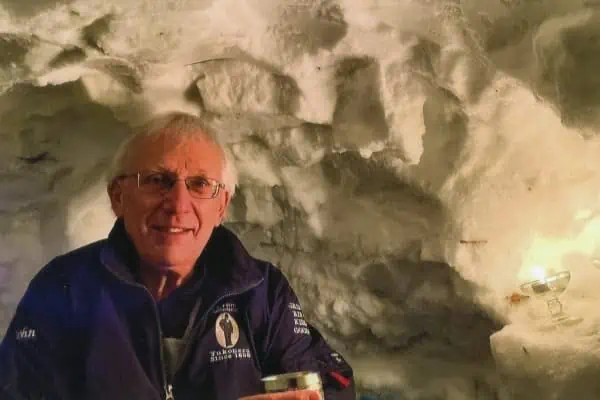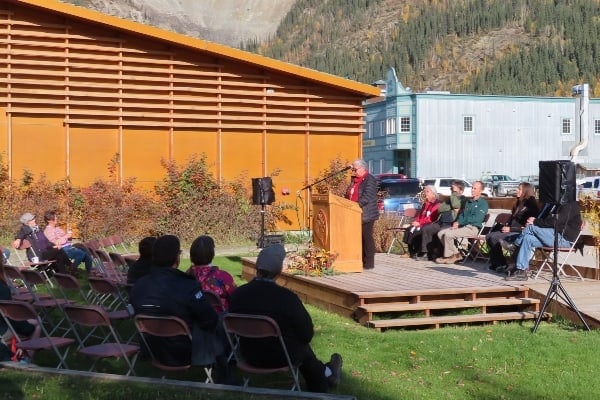On July 8, 1992, the Whitehorse Star reported a find near Frances Lake of what was stated to be a world-record-sized piece of jade at 577 tonnes. It was speculated to be worth $5.8 billion. There is no consensus on what is the largest piece of jade ever found. To start, there are two different types of jade and it has many imposters.
The one record that can be confirmed is the largest carved piece of jade. This is a statue of Buddha located in Anshan, China. The statue weights in at 260 tonnes and is from a piece of jade from British Columbia.
The name jade comes from the Spanish ijada. When the Spanish first reached what is now Mexico, they noticed the Indigenous Aztecs ground up this green rock and made it into a drink for people who were sick. They called it the piedra de ijada or stone of colic. The Aztecs valued the rock more than gold, whereas the Spanish just wanted the gold.
There are two varieties of rock known as jade: nephrite and jadeite. Nephrite is made of the mineral group known as amphiboles. Jadeite is made of pyroxene minerals. The difference is in the chemistry. Nephrite is formed by a double chain of silicon and oxygen molecules or silicates. Jadeite is formed by only one silicate chain. Other elements can attach to these chains, such as calcium, sodium, aluminum, iron and chromium. Those different elements will help determine the colour of the rock. Jade can be green, white, black, blue, red or yellow.
Nephrite is lighter than jadeite and is a bit softer, but it is tougher. Toughness is the ability to resist breakage. It goes back to the double chain of silicates the rock is made up of. These chains form twisted aggregates of minerals woven together in an interlocking pattern, making it tougher than steel.
British Columbia is the world’s largest producer of nephrite in the world; it is their official gemstone. The Dease Lake and Cassiar areas are the most prolific jade-producing areas in the province, and this belt extends up into the Yukon.
The largest producer of jadeite in the world has always been Burma, now Myanmar. Most of this goes to China for processing. Jadeite sales make up a large portion of Myanmar’s gross domestic product (GDP). It is an industry reportedly ripe with corruption.
There are no known jadeite deposits in North America north of California, just nephrite.
Jade is generally associated with rocks known as serpentinites. Serpentinites are formed from very dark (ultramafic) rocks formed from the Earth’s mantle. In the presence of seawater and the addition of heat and some pressure, these ultramafics metamorphose into serpentinite. Areas of the Earth’s crust, where tectonic plates are sliding by each other, produce the required heat and pressure.
Jade is formed from the serpentinite through further metamorphism and chemical reactions with surrounding rocks. Jade bodies are not usually very large. The pods of jade at King Arctic, near Frances Lake, were about five metres wide and 15 metres long, around 1,000 tonnes or so. Some of the larger pods found in British Columbia are only about 3,500 tonnes.
In areas where jade was originally found, the Indigenous people of the area made use of it. Jadeite has been found in some of the oldest graves found in China. Axe blades made of jade have been found in Guatemala that date back to 1200 BCE. In the Fraser River area, in British Columbia, nephrite blades and rings have been dated back to 4000 years BCE.
Jade was used for both ornamental and practical use. The toughness of the nephrite jade made it ideal for axe heads and chisels. You cannot shape jade with metal chisels. The only method of shaping nephrite is with the use of abrasion. Today, diamond-tipped tools do the job, but the Indigenous people used a softer rock to rub abrasive material, like quartz-rich sand mixed with water, over the jade. Dozens of hours could be spent manually wearing the nephrite into the shape you wanted. Recreating these techniques today shows that nephrite can be worn down one to two millimetres an hour, by hand.
The sources of the nephrite used thousands of years ago in B.C. were boulders and cobbles found in the Fraser River, south of Lillooet. Since nephrite is so tough, large pieces can be transported naturally many kilometres from the source, intact.
This way of collecting jade has not changed all that much in modern times. The nephrite jade in the Dease Lake–Cassiar region occurs as rounded boulders in creeks, and glacial deposits. Eventually these are tracing back to the source. Nephrite was most certainly utilized by the early Indigenous people of the area, but it was not until the late 1970s that commercial operations started in the area.
The value of jade is based on colour, clarity, translucency and texture. It is very difficult to evaluate a boulder of jade from the outside. The rock weathers a brownish grey, so it either has to be drilled and cored or a slice taken off to really tell how valuable the piece may be. Low-grade jadeite and nephrite sell for about the same price. High-grade jadeite is much more valuable than high-grade nephrite.
Another very important property is how free of fractures the rock is. Fractures can limit how large a sculpture could be. For that reason, jade cannot be mined by blasting. The explosives would create microfractures in the jade, even far away from the blast.
The Cassiar asbestos mine contained a lot of good-quality nephrite, but the fracturing caused by the mining for asbestos meant only small intact pieces could be salvaged. In the early years at Cassiar, much of the jade was discarded in waste piles because the company was only interested in asbestos.
Once a boulder has been evaluated, it has to be moved out to be sold or processed. If the jade is valuable and small enough, it can be flown out by helicopter. Large pieces are usually moved out in the winter by sled, with dozers. If a boulder is too big to move or it is mined from the source, miners can use wire saws mounted with diamonds to slice off manageable pieces. They can also be drilled and hydraulic spreaders inserted in the holes to force the rock apart.
Very much like the Yukon’s placer miners, most jade mining is done by small operations, sometimes just mom and pop. Discovery Channel has a show like the Yukon Gold production, but based on jade mining in northwestern British Columbia, Jade Fever.
If you want to get out and find your own jade, look for areas with serpentinite rock, to start. There are a number of occurrences of serpentinites: south and east of Marsh Lake, down towards Atlin, east of Quiet Lake, the north Alaska Highway—Kluane area, and Clinton Creek, to name a few. No jade has been found at any of these, yet.
The Frances Lake area find in 1992 was on the King Arctic property located west of the Robert Campbell Highway, about 120 kilometres north of Watson Lake. Jade on the property was commercially produced there in the late 1980s and early ’90s.
The best place to start your search would be Jade City, British Columbia, about 120 kilometres down Highway 37 from the Alaska Highway. They have a yard full of jade boulders from area operations. They also have informative staff who are cutting, polishing and selling jade. You might even run into the stars of Jade Fever there.




